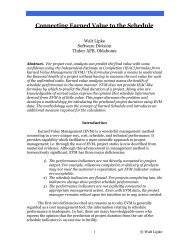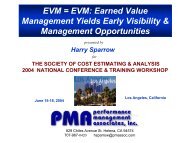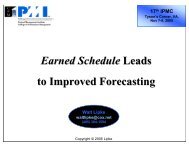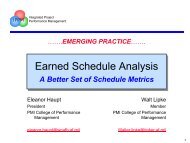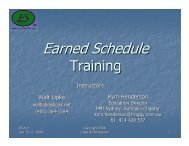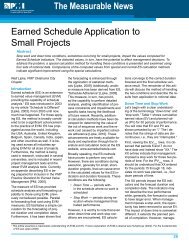Earned Schedule: A Breakthrough Extension to Earned Value ...
Earned Schedule: A Breakthrough Extension to Earned Value ...
Earned Schedule: A Breakthrough Extension to Earned Value ...
Create successful ePaper yourself
Turn your PDF publications into a flip-book with our unique Google optimized e-Paper software.
IEAC(t) = AT + (PD – ES) / PF(t), where AT is the Actual Time, PD is the Planned Duration and PF(t) is a selected<br />
time performance fac<strong>to</strong>r.<br />
Henderson (Henderson 2004) also compared the outcomes predicted using the ES “short form” formula and the<br />
“pre-ES” outcome prediction techniques using EVM data described by Anbari (Anbari 2003) using real project data.<br />
This analysis demonstrated that only the ES outcome prediction techniques produced algebraically correct results<br />
and which also mimicked the behaviour of the EVM cost predic<strong>to</strong>rs.<br />
Commerical IT Infrastructure Expansion Project: Phases 2 & 3 Combined<br />
Cost and <strong>Schedule</strong> Variances<br />
as at Project Completion: Week Starting 9th Oc<strong>to</strong>ber xx<br />
Target SV & CV CV cum SV ($) cum SV (t) cum<br />
Dollars ($,000)<br />
55.0<br />
45.0<br />
35.0<br />
25.0<br />
15.0<br />
5.0<br />
-5.0<br />
-15.0<br />
-25.0<br />
1 2 3 4 5 6 7 8 9 10 11 12 13 14 15 16 17 18 19 20 21 22 23 24 25<br />
Elapsed Weeks<br />
5.0<br />
4.0<br />
3.0<br />
2.0<br />
1.0<br />
0.0<br />
-1.0<br />
-2.0<br />
Weeks<br />
Exhibit 4 – “Early Finish” Project Cost and <strong>Schedule</strong> Variances<br />
<strong>Earned</strong> <strong>Schedule</strong> Application<br />
Since the <strong>Earned</strong> <strong>Schedule</strong> seminal paper was first published by Lipke in 2003 very significant levels of interest in<br />
and adoption of the ES methodology has occurred. The Project Management Institute - College of Performance<br />
Management (PMI-CPM) interest in the new practice resulted in an “emerging practice” insert, which cited the<br />
principles of ES being included in the 2004 release of the PMI-CPM Practice Standard for <strong>Earned</strong> <strong>Value</strong><br />
Management (PMI 2004).<br />
Significant publicised applications of ES in the United States include:<br />
• United States Air Force Acquisition Integration (SAF/AQX) in acquisition oversight<br />
• Boeing Dreamliner®<br />
• Lockheed Martin [1].<br />
Known application in other countries include<br />
• Two major United Kingdom Ministry of Defence programs applying ES include the Nimrod MRA4<br />
(maritime patrol aircraft), see Higgins 2006 and Type 45 destroyer programs.<br />
• Several smaller applications, many IT related projects, have occurred in Belgium by Fabricom Airport<br />
Systems, as well as others in Australia and the USA.<br />
ES Terminology<br />
As interest in and the application of ES grew, the need for a common set of terminology was recognized. The<br />
principals and interested parties agreed <strong>to</strong> a recommendation from a meeting held at the PMI-CPM Conference in<br />
2004 that the ES terms should be parallel <strong>to</strong>, but readily distinguishable from the EVM terms. This was thought <strong>to</strong><br />
encourage the application of ES by minimising the learning curve required by existing EVM and new practitioners<br />
alike. As shown in exhibit 5, the chosen terms are readily comparable <strong>to</strong> the EVM counterpart. In most cases, the ES<br />
term is the analogous EVM term appended by the suffix “(t)” for “time”.<br />
© Kym Henderson Page 6 of 10<br />
Originally published as a part of 2007 PMI Asia Pacific Global Congress Proceedings – Hong Kong



